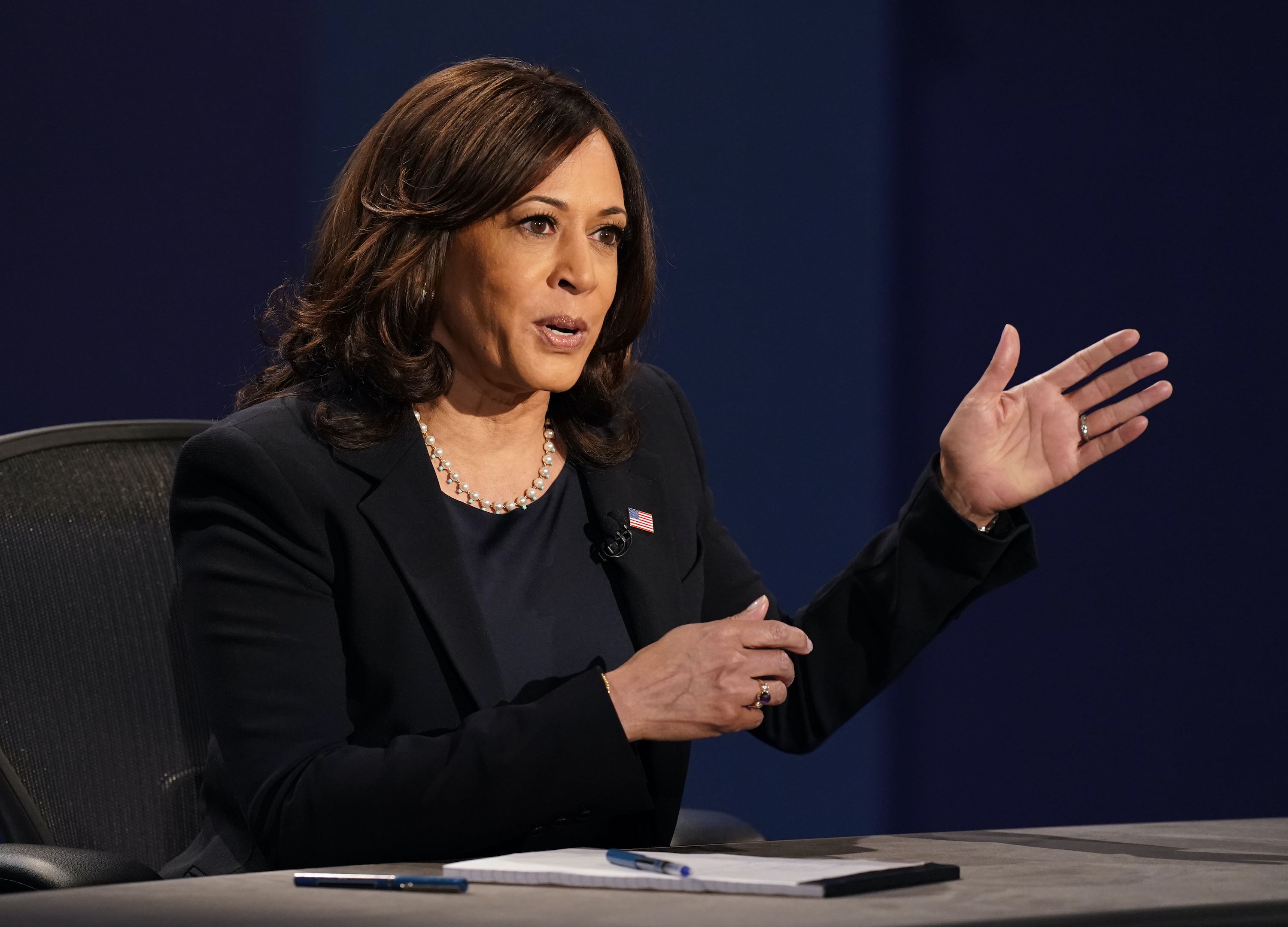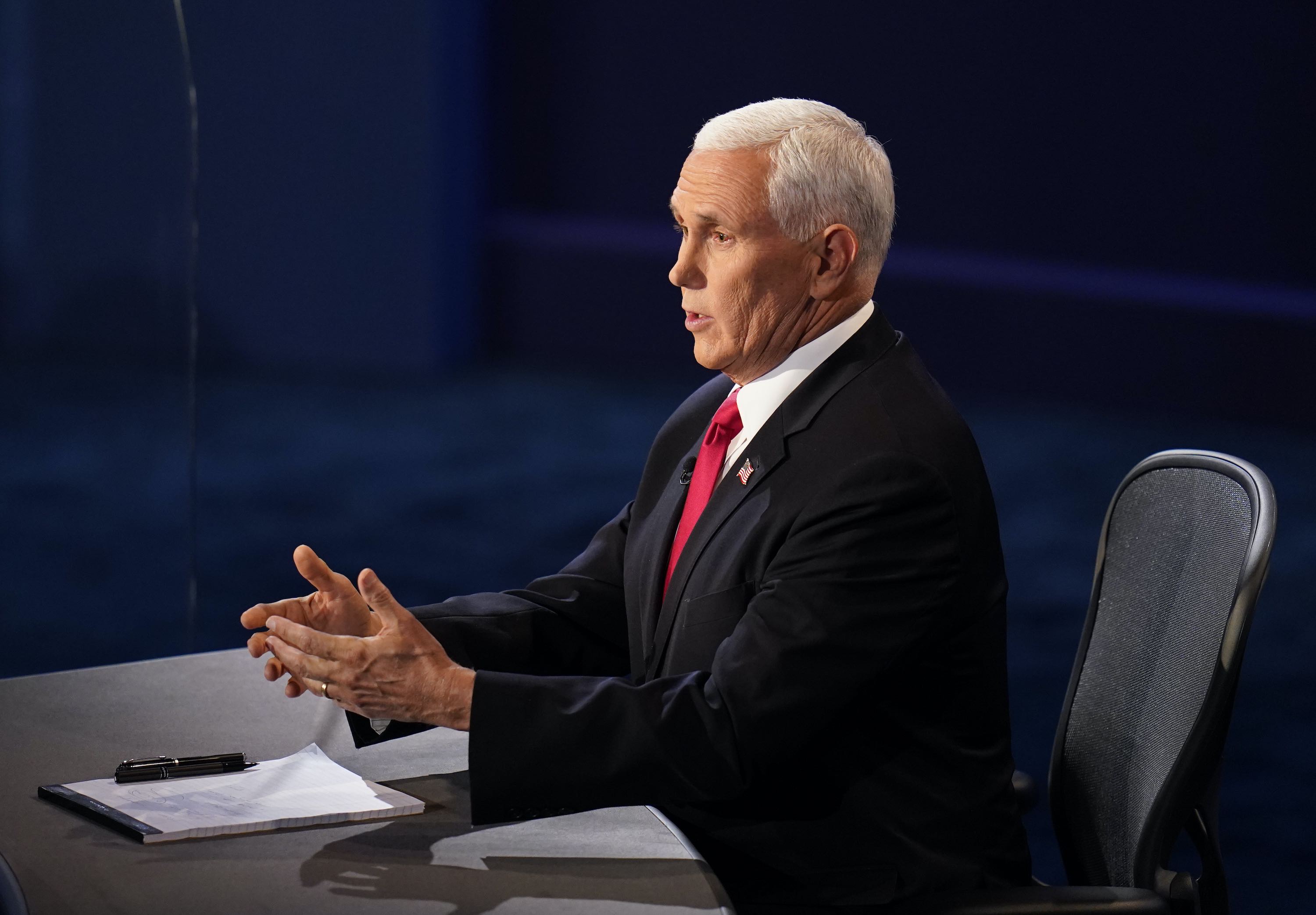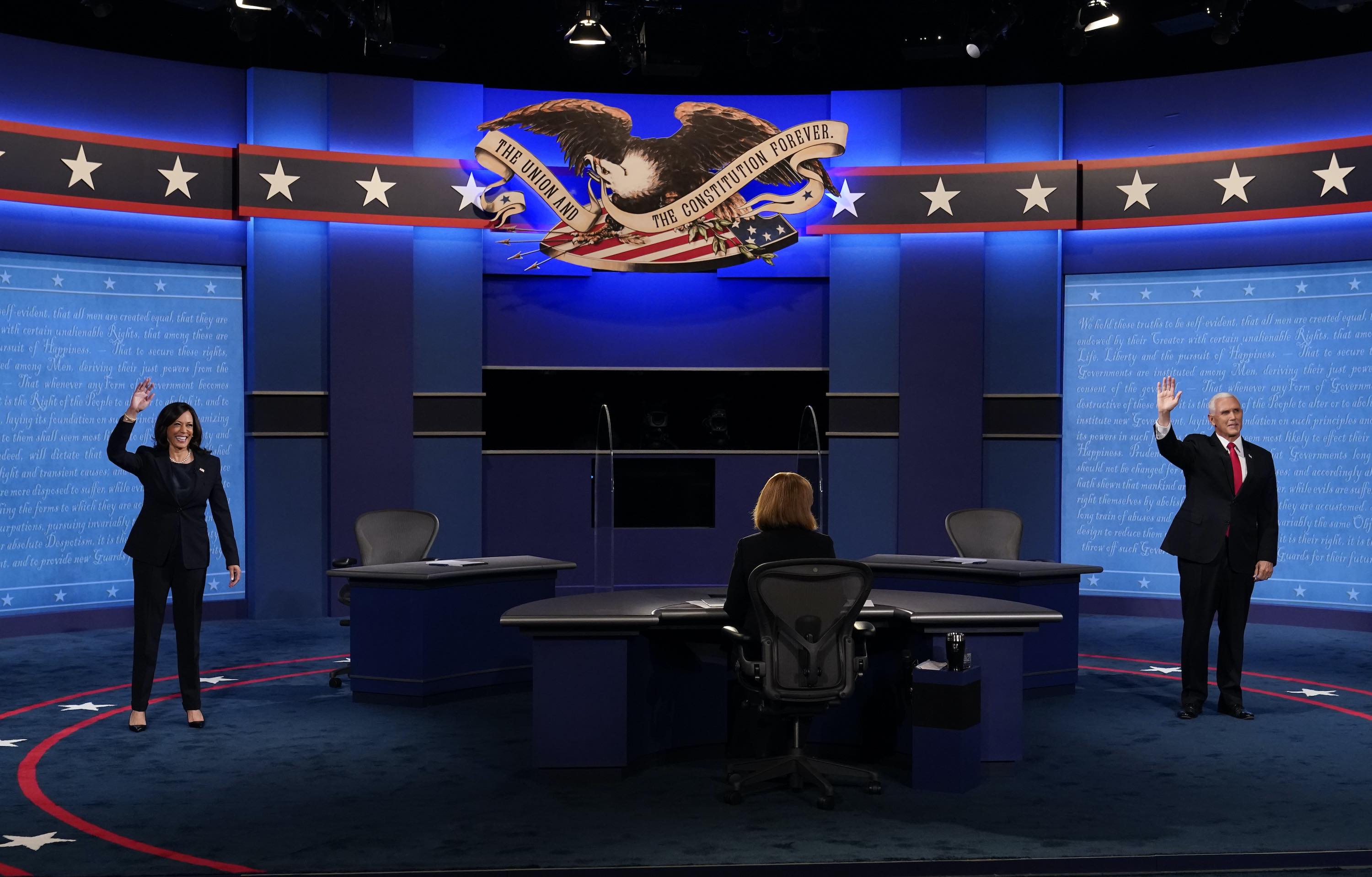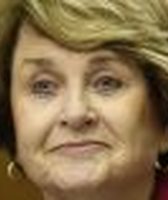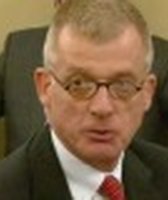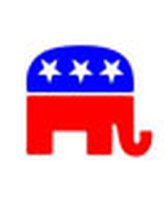Stand up for the facts!
Our only agenda is to publish the truth so you can be an informed participant in democracy.
We need your help.
I would like to contribute
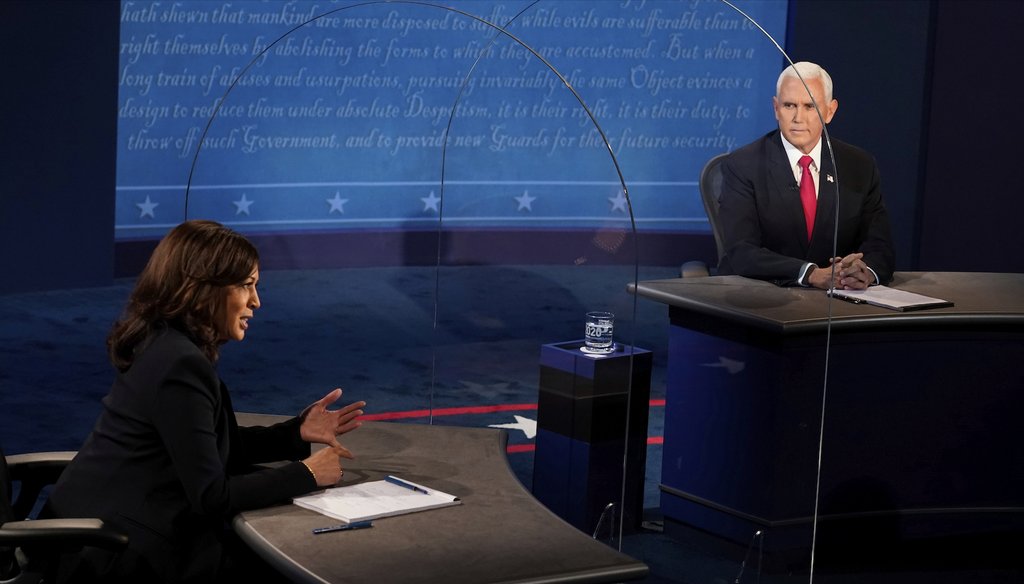
Vice President Mike Pence looks at Democratic vice presidential candidate Sen. Kamala Harris, D-Calif., as she answers a question during the vice presidential debate Oct. 7, 2020, at Kingsbury Hall on the campus of the University of Utah. (AP)
Plexiglass partitions didn’t stop the vice presidential candidates from clashing over the coronavirus, taxes, China, health care, and climate change.
In a civil but pointed 90-minute exchange, Democrat Sen. Kamala Harris exaggerated the failings of the Trump administration’s handling of the pandemic and the economy. Vice President Mike Pence repeatedly used the phrase "the reality is ..." to introduce claims that didn’t measure up. They both ignored pointed questions from moderator Susan Page in favor of deploying their own talking points.
Here’s a rundown of what we fact-checked from the Oct. 7 debate in Salt Lake City.
Kamala Harris: "The president said (the coronavirus) was a hoax."
Rating: False
This often-repeated statement falsely attributed to President Donald Trump has its roots in a Feb. 28 rally in South Carolina. But it’s a mischaracterization of what he actually said, which was an attack on Democrats’ response to the virus.
Trump cast the Democrats’ criticism of his work as foisting a hoax on the public. "They tried the impeachment hoax," he said. "That was not a perfect conversation. They tried anything. They tried it over and over. They’d been doing it since you got in. It’s all turning. They lost. It’s all turning. Think of it. Think of it. And this is their new hoax."
RELATED: Experts pan plexiglass at VP debate
Mike Pence: The Rose Garden event with Judge Amy Coney Barrett "was an outdoor event, which all of our scientists regularly and routinely advised."
Wrong
The event included an indoor component, during which President Trump, Barrett and others posed for photos without wearing masks. Public health officials do say outdoor activities — where people are wearing masks and have the room to social distance — are less risky amid the pandemic than indoor events, where it might be harder to keep people apart and there’s less ventilation. But attendees of the Sept. 26 White House event for the nomination of Judge Amy Coney Barrett to the Supreme Court did not practice social distancing, and many did not wear masks throughout the event.
Pence: Trump "suspended all travel from China. ... Joe Biden opposed that decision. He called it xenophobic and hysterical."
Misleading
There were exemptions in Trump’s travel restrictions on China. On Jan. 21, the Centers for Disease Control and Prevention confirmed the first U.S. case of the new coronavirus, a patient in Washington state who had traveled from Wuhan, China. On Jan. 31, the Trump administration announced a ban on travelers from China, but it exempted several categories of people, including U.S. citizens and lawful permanent residents. It went into effect Feb. 2.
According to the New York Times, about 40,000 people traveled from China to the United States in the two months after Trump announced travel restrictions, and 60% of people on direct flights from China were not U.S. citizens.
As for the "xenophobic" and "hysterical" comment, Biden has not directly said that the restrictions were xenophobic. Around the time the Trump administration announced the travel restriction, Biden said that Trump had a "record of hysteria, xenophobia, and fear-mongering." Biden also used the phrase "xenophobic" in reply to a Trump tweet about limiting entry to travelers from China and in which the president described the coronavirus as the "Chinese virus."
(AP)
Harris: Obama "created within the White House an office that basically was responsible for monitoring pandemics. They got rid of it. There was a team of disease experts that President Obama and Vice President Biden dispatched to China to monitor what is now predictable and what might happen. They pulled them out."
Largely accurate
Harris described two pieces of the federal government's operation to protect against new viral threats. There was a division within the White House National Security Council. And there was a Centers for Disease Control and Prevention office in China.
In May 2018, the top White House official in charge of the U.S. response to pandemics left the administration. His position was not filled. Then-National Security Adviser John Bolton reorganized the White House global health team. Tom Bossert, a homeland security adviser who recommended strong defenses against disease and biological warfare, left in 2018. Neither Bossert nor the official overseeing the U.S. pandemic response, nor their teams, were replaced. Some of their responsibilities were farmed out to other corners of the administration.
In China, the CDC program specifically charged with spotting new infectious diseases went from having four American staff in 2017 to none by 2019.
Pence: "(Biden’s) own chief of staff, Ron Klain, would say last year that it was pure luck, that they did ‘everything possible wrong’ (with H1N1). And we learned from that."
Needs context
Ron Klain, Biden’s former chief of staff, spoke about H1N1 during a biosecurity conference in May 2019: "A bunch of really talented, really great people working on it, and we did every possible thing wrong. And it’s, you know, 60 million Americans got H1N1 in that period of time. And it’s just purely a fortuity that this isn't one of the great mass casualty events in American history. It had nothing to do with us doing anything right. It just had to do with luck."
Klain has since told Politico and FactCheck.org that his comments were taken out of context, and that they were specifically in reference to the Obama administration’s difficulties meeting the public demand for an H1N1 vaccine. He was not talking about Biden directly.
(AP)
Pence: The Obama administration "left the strategic national stockpile empty."
Rating: Mostly False
The Obama administration did not leave an "empty" national stockpile. Just months before COVID-19 cases popped up in the U.S., the former director of the stockpile described it as an $8 billion enterprise with extensive holdings of many needed items. But N95 masks, for example, had been depleted after the H1N1 outbreak in 2009.
Pence: On the nation’s COVID-19 response, "the reality is, when you look at the Biden plan, it reads an awful lot like what President Trump and I and our task force have been doing every step of the way."
Misleading
At first glance, the Biden plan does track closely with some of the talking points advanced by the Trump administration — the need to develop and distribute a vaccine, provide COVID-19 tests free, reduce costs for COVID-19 treatments and produce necessary protective equipment and ventilators. But Biden’s plan also proposes many other priorities that the Trump administration has not pursued. Biden also has, throughout the campaign, followed recommendations about mask wearing and social distancing that the Trump administration has defied — a pattern that’s being blamed for Trump’s own infection with COVID-19 and the current outbreak at the White House.
Pence: The Obama administration "left an empty and hollow plan."
Misleading
The Obama administration left a "playbook" that detailed steps to take in the event of an infectious disease outbreak. The 69-page document from 2016 was a National Security Council guidebook created to assist leaders "in coordinating a complex U.S. government response to a high-consequence emerging disease threat anywhere in the world."
Harris: "Today they still don’t have a plan" regarding the pandemic.
Needs context
Biden said the same thing during the first presidential debate. The Trump administration does have a plan to distribute vaccines once they are produced. But experts say the administration has failed to produce a national testing plan or a national strategy to address the COVID-19 pandemic. The administration maintains its emphasis has been on helping the economy reopen. However, it has fallen short in executing a coordinated response between the federal government and states to combat the coronavirus. More than 210,000 Americans have died from COVID-19, more than in any other country.
Pence (to Harris): "The fact that you continue to undermine public confidence in a vaccine, if a vaccine emerges during the Trump administration, I think is unconscionable."
Needs context
Harris said during the debate that she would not trust Trump’s word that a vaccine is effective, insisting she would instead trust an expert opinion, such as Dr. Anthony Fauci: "I will be the first in line to take it, absolutely." Harris recently suggested Trump would push a vaccine before it was ready to help his electoral chances. But Harris is also voicing concerns shared by many Americans; last month a Pew poll found Americans are divided on whether to get a COVID-19 vaccine, with 78 percent saying they are worried it will be approved too quickly.
Harris: "The president hasn’t been transparent in terms of health records."
Accurate
After Trump announced his COVID diagnosis and was admitted to Walter Reed National Military Medical Center for treatment, White House Dr. Sean Conley briefed reporters on the president’s health. Conley provided selective information and declined to answer questions, such as when the president first tested positive for the disease or on the condition of his lungs. Conley said he couldn’t share this information citing HIPAA, the Health Insurance Portability and Accountability Act of 1996. Experts told us that HIPAA does prohibit Conley from sharing any health information that the president hasn’t authorized him to share. However, if Trump wanted his doctor to be transparent, he could waive HIPAA protections. Beyond the recent questions about Trump and COVID-19, Trump has shared less general health information compared with past presidents. But there’s also no law that requires health information disclosures by presidents.
Pence: Joe Biden and Kamala Harris "want to abolish fossil fuels and ban fracking."
Rating: False
Biden has not called for banning fracking outright. He wants to block the federal government from issuing new permits for drilling on public land. Biden says that he won’t shut down existing fracking operations on public land, and that he’ll allow fracking to continue on private lands, where most of it takes place.
Biden appeared to say that he supports a ban on "new fracking" during a debate with Bernie Sanders. However, he walked back those remarks the same day and has consistently said that he doesn’t support a ban on fracking.
The claim that Biden and Harris want to "abolish fossil fuels" is based on partial quotes that reference Biden’s climate change plan, which seeks to achieve net-zero emissions by 2050. In September 2019, Biden told a supporter, "I guarantee you we’re going to end fossil fuel." He then said: "Before 2050, God willing. No, it can’t be done by 2030. No. There is not one single person that’s argued it can be done by then. But it can be done by 2050, it may be 2045."At another town hall in February 2020, Biden told a heckler in the crowd, "We are going to get rid of fossil fuels." Then Biden said, "We’re going to phase out fossil fuels."
Harris: "On day one, Joe Biden will repeal that tax bill. He will get rid of it."
Needs context
Harris leaves out details of Biden’s tax plan. Biden does not call for a full repeal of Trump’s 2017 tax law, which disproportionately benefited the wealthy while giving cuts to more modest earners. Biden’s plan would roll back some of the cuts for corporations and people with taxable incomes over $400,000.
Specifically, Biden would increase the top corporate tax rate from 21% to 28%, which is lower than the rate of 35% that existed before Trump’s law. Biden would also raise the top federal marginal income tax rate for individuals from 37% to the old rate of 39.6%.
Later in the debate, Harris clarified that Biden’s tax plan would not directly raise taxes on anyone making less than $400,000 per year. Independent tax analysts found that to be the case, noting that lower earners could experience small hits from the indirect effects of an increased corporate tax rate.
(AP)
Pence: The Trump administration "inherited the slowest economic recovery" from the Obama-Biden administration.
Misleading
This is a glass-half-empty, glass-half-full scenario.
It’s accurate to say that the recovery from the Great Recession that began in the summer of 2009 and lasted until the coronavirus hit was the weakest recovery from a recession in U.S. history. (The first seven-plus years of the recovery were on Obama’s watch, while the next three-plus years were on Trump’s watch.)
Annual GDP growth rates during recoveries tended to reach or exceed 5% through the presidency of Bill Clinton. Under Clinton’s successor, George W. Bush, they maxed out at about 4%. Under Obama, growth was smaller still, usually 3% or below. Overall, GDP growth rates under Obama and Trump have been similar.
The flip side is that the recovery that began under Obama and continued under Trump set a record for the length of a recovery in July 2019, when it hit 121 months. The recovery would continue for another half a year before the pandemic began. By contrast, going back to the 1850s, only two recoveries — those that began under Clinton and John F. Kennedy — cracked 100 months.
Harris: "There are estimates that by the end of the term of this administration, they will have lost more jobs than almost any other presidential administration."
Rating: Half True
As of now, Trump is looking at a loss of about 4 million jobs since he took office. That indeed would give him one of the worst records on job creation going back to President Harry Truman. But no other president has faced a pandemic that cratered the economy. And no one can know for sure if any president would have done much better.
Prior to the pandemic, if we look at employment gains in the first three years of Trump presidency, Trump comes in fourth behind Presidents Bill Cllinton, Jimmy Carter and Lyndon Johnson.
Pence: "Joe Biden wants to repeal all of the tariffs that President Trump put into effect to fight for American jobs and American workers."
Misleading
Biden has not publicly committed to repealing the tariffs that Trump imposed on Chinese products. He has been ambiguous about the tariffs in his public appearances, saying only that he’ll evaluate them once in office.
However, Biden has been critical of Trump’s trade war with China, calling for a more targeted confrontation with the country and saying that he would shore up allegiances to oppose it multilaterally.
Harris: "Because of a so-called trade war with China, America lost 300,000 manufacturing jobs. Farmers have experienced bankruptcy because of it."
Needs Context
Harris is most likely referencing a 2019 report by the forecasting firm Moody’s Analytics, which found that Trump’s trade war with China had cut American employment by 300,000 jobs. Not all of these jobs were manufacturing jobs, although the report noted that manufacturing was one of the hardest-hit industries along with warehousing, distribution, and retail.
The number of farmer bankruptcies did rise during the trade war. However, farm bankruptcies have been increasing each year since 2014. Experts said the trade policy is just one factor driving the increase, along with low commodity prices and natural disasters.
Pence: "This administration saw 500,000 manufacturing jobs created."
Misleading
Pence’s figure ignores the recession caused by the pandemic. Between the time Trump became president in January 2017 and March 2020 — right as the pandemic hit — the number of manufacturing jobs grew from 12.37 million to 12.81 million, an increase of about 437,000.
By August 2020, however, the number of manufacturing jobs had fallen to 12.13 million. This means that on Trump’s watch, the change in manufacturing jobs has actually been negative, dropping by 237,000. These jobs may come back when the coronavirus is no longer a threat and the economy recovers, but that’s not the situation we’re in now, and a full recovery is no certainty.
Harris: "Do you know that of the 50 people who President Trump appointed to the court of appeals for lifetime appointments, not one is Black?"
Accurate
Bloomberg Law reported in June that none of Trump’s 53 confirmed appeals court judges are Black. One is Hispanic. Seven are Asian American.
PolitiFact confirmed Bloomberg Law’s reporting using data from the Federal Judicial Center, the research and education agency for the nation’s federal courts.
Pence: "The Green New Deal's on their campaign website."
Needs context
U.S. Rep. Alexandria Ocasio-Cortez’ Green New Deal resolution does appear on the Biden-Harris campaign website in a discussion of Biden’s climate action plan. Biden’s plan calls the Green New Deal "a crucial framework for meeting the climate challenges we face." According to his website, the plan borrows "two basic truths" from the Green New Deal: that the U.S. needs to be more ambitious, and that the environment and economy are connected.
But while the Biden plan shares some of the goals of the Green New Deal — such as net-zero carbon emissions by 2050 — it differs significantly in scope, and leaves out agenda items such as universal health care and affordable housing.
Harris: "I served, when I first got to the Senate, on the committee that’s responsible for the environment. Did you know, this administration took the word ‘science’ off the website? And then took the phrase ‘climate change’ off the website?"
Largely accurate
A 2018 study by the Environmental Data & Governance Initiative, a watchdog group that analyzes federal environmental data, websites, institutions and policy, tracked a year of editing of U.S. government websites and found a significant overhaul of information on climate change during the Trump administration.
References to climate change, greenhouse gases, renewable energy, science and more were reformatted or removed completely from several government websites, including the Environmental Protection Agency, the Energy Department and the White House. For example, the website of the EPA's Office of Science and Technology Policy, which develops clean water standards, once described those standards as "science-based." But since Jan. 30, 2017, that reference has disappeared.’
On the current website for the Senate Committee on Environment and Public Works, the body Harris referenced, we found links to old hearings that contained references to "climate change," but found no mention of the phrase, or the word "science," on any other area of the site. It’s not clear whether the administration had any role in that.
Pence: Biden and Harris support abortion "all the way up to the moment of birth."
Misleading
Biden and Harris have not said they support abortion up to the moment of birth. They say they support Roe vs. Wade, the landmark Supreme Court case that legalized abortion while giving states the ability to regulate it after a certain point. Biden and Harris say they want to codify Roe vs. Wade into law and are against state laws that they say violate the rulings in the case. Supporting Roe vs. Wade is not the same as supporting abortion up to the moment of birth, experts say.
"Because Roe allows states to prohibit abortion once a fetus is viable, agreement with the case does not indicate support for abortions ‘up to the moment of birth’," said Darren Hutchinson, a law professor at the University of Florida Levin College of Law.
Harris: When Abraham Lincoln was faced with a Supreme Court vacancy 27 days before Election Day and his party controlled the Senate, he said the people should vote first.
Needs context
According to Harris’ "history lesson," Lincoln was up for reelection when the chief justice, Roger Taney, died on Oct. 12, 1864, just 27 days before the election. She’s right about the proximity of Taney’s death to the election; it was the shortest such vacancy before an election in history. And Lincoln did not seek confirmation of his nominee, Salmon P. Chase, until Dec. 6, which was after the election.
The Biden campaign pointed to a tweet during the debate by historian Michael Beschloss. However, it’s hard to confirm that Lincoln’s motivations were as high-minded as Harris suggested in her rendering of his thinking.
"I don’t think there is a definite answer" for why Lincoln waited, Stephen E Maizlish, a historian at the University of Texas-Arlington and biographer of Chase, told PolitiFact. "Abraham Lincoln was a master politician and kept his cards close to the vest until he was ready for a decision. … I think there will always be questions.
Jon Greenberg, Louis Jacobson, Noah Y. Kim, Bill McCarthy, Hayat Norimine, Samantha Putterman, Amy Sherman, and Miriam Valverde and Kaiser Health News reporters Emmarie Huetteman and Victoria Knight contributed to this report.
CORRECTION: This report has been corrected to note that Trump made his hoax comments in South Carolina, not North Carolina; and that Roger Taney's birth year was 1864, not 1984. We also updated this story to include two of Biden’s statements on ending or phasing out fossil fuels during the campaign, with added context.
(This story was last updated 7:45 p.m., Oct. 13.)
It’s never been more important to know the facts...
2020 is not what any of us expected. We thought we’d be fact-checking a spirited political debate about the economy, health care and more ahead of voting in November.
Well, we’re still doing that, but in the midst of the worst public health crisis in a century.
The coronavirus pandemic has been a call to action for all fact-checking newsrooms like ours to root out harmful hoaxes because, and we can say this with certainty, every single person in the U.S. is affected by the spread of COVID-19 and misinformation around it.
And, while it’s never been more essential to read our fact-checking, PolitiFact is not immune from the economic uncertainty that the pandemic brings. We’re doing everything in our power to expand our coverage of both COVID-19 and Election 2020 as a public service to all those who need it. Without a paywall, we’re humbly asking for donations from readers like you to support our newsroom as we continue to provide you with the truth.
Thank you for reading PolitiFact.
This fact check is available at IFCN’s 2020 US Elections FactChat #Chatbot on WhatsApp. Click here, for more.
Our Sources
See fact-checks and linked resources.
